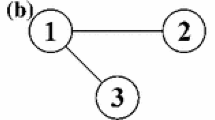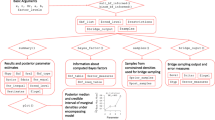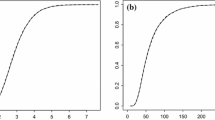Abstract
We derive an explicit form of a Markov basis on the junction tree for a decomposable log-linear model. Then we give a description of a Markov basis characterized by global Markov properties associated with the graph of a decomposable log-linear model and show how to use the Markov basis for generating contingency tables of a Markov chain. The estimates of exact \(p\)-values can be obtained from contingency tables generated from the proposed Markov chain Monte Carlo using the Markov basis.



Similar content being viewed by others
References
Blair JRS, Barry P (1993) An introduction to chordal graphs and clique trees. In: Graph theory and sparse matrix computation. IMA vol Math Appl 56. Springer, New York, pp 1–30
Dalenius P, Reiss RS (1982) Data-swapping: a technique for disclosure control. J Stat Plan Inference 6:73–85
Diaconis P, Sturmfels B (1998) Algebraic algorithms for sampling from conditional distributions. Ann Stat 26:363–397
Dobra A (2003) Markov bases for decomposable graphical models. Bernoulli 9:1093–1108
Geiger D, Meek Ch, Sturmfels B (2006) On the toric algebra of graphical models. Ann Stat 34:1463–1492
Geyer CJ (1992) Practical Markov Chain Monte Carlo. Stat Sci 7:473–483
Goorin AM, Perez-Atayde A, Gebhardt M, Andersen JW, Wilkinson RH, Delorey MJ, Watts H, Link M, Jaffe N, Frei DE III (1987) Weekly high-dose methotrexate and doxorubicin for osteosarcoma: the Dana-Farber Cancer Institute/the Children’s Hospital-study III. J Clin Oncol 5:1178–1184
Hájek P, Havránek T, Jiroušek R (1992) Uncertain information processing in expert systems. CRC Press, Boca Raton
Hara H, Aoki S, Takemura A (2010) Minimal and minimal invariant Markov bases of decomposable models for contingency tables. Bernoulli 16:208–233
Hastings WK (1970) Monte Carlo sampling methods using Markov chains and their applications. Biometrika 57:97–109
Innes JR, Ulland BM, Valerio MG, Petrucelli L, Fishbein L, Hart ER, Pallotta AJ, Bates RR, Falk HL, Gart JJ, Klein M, Mitchell I, Peters J (1969) Bioassay of pesticides and industrial chemicals for tumorigenicity in mice: a preliminary note. J Natl Cancer Inst 42:1101–1114
Jensen FV, Jensen F (1994) Optimal junction trees. In: de Mantaras RL, Poole D (eds) Proceedings of the 10th conference on uncertainty in artificial intelligence. Morgan Kaufmann, San Mateo, pp 360–366
Jones GL, Haran M, Caffo BS, Neath R (2006) Fixed width output analysis for Markov chain Monte Carlo. J Am Stat Assoc 101:1537–1547
Lauritzen SL (1996) Graphical models. Oxford University Press, New York
Muller T, Mayhall JT (1971) Analysis of contingency table data on torus mandibularis using a log linear model. Am J Phys Anthropol 34:149–153
Acknowledgments
The authors would like to thank the editor and referees whose valuable comments and kind suggestions that led to an improvement of this paper. This research is supported by the Japan Society for the Promotion of Science (JSPS), Grant-in-Aid for Scientific Research (C), No. 20500263.
Author information
Authors and Affiliations
Corresponding author
Appendix: Configuration \(A\) of the conditional independence model for a three-way contingency table
Appendix: Configuration \(A\) of the conditional independence model for a three-way contingency table
We consider a \(2 \times 2 \times 3\) table cross-classified by \(X=(X_{1},X_{2},X_{3})\). For the table, we assume the conditional independence that \(X_{1} \perp X_{2} | X_{3}\). When we consider the reverse lexicographic order of the cell indices in \(\{1,2\} \times \{1,2\} \times \{1,2,3\}\), that is, \((1,1,1),(2,1,1),\ldots ,(2,2,3)\), \(A\) for the conditional independence model is given by
By permuting rows of A, we have the block diagonal matrix
Rights and permissions
About this article
Cite this article
Kuroda, M., Hashiguchi, H., Nakagawa, S. et al. MCMC using Markov bases for computing \(p\)-values in decomposable log-linear models. Comput Stat 28, 831–850 (2013). https://doi.org/10.1007/s00180-012-0331-3
Received:
Accepted:
Published:
Issue Date:
DOI: https://doi.org/10.1007/s00180-012-0331-3




